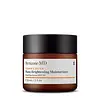Cetaphil Daily Facial Moisturizer SPF 50 Versus Perricone MD Vitamin C Ester Photo-Brightening Moisturiser Broad Spectrum SPF 30
What's inside
What's inside
 Key Ingredients
Key Ingredients

 Benefits
Benefits

 Concerns
Concerns

 Ingredients Side-by-side
Ingredients Side-by-side

Ethylhexyl Methoxycinnamate 7.5%
UV AbsorberEthylhexyl Salicylate 5%
UV AbsorberOctocrylene 7%
UV AbsorberBenzophenone-3 6%
UV AbsorberTitanium Dioxide 5.7%
Cosmetic ColorantWater
Skin ConditioningPropylene Glycol
HumectantGlycerin
HumectantDimethicone
EmollientVp/Eicosene Copolymer
Cyclomethicone
EmollientStearic Acid
CleansingDimethiconol
EmollientPotassium Cetyl Phosphate
EmulsifyingGlyceryl Stearate
EmollientPEG-100 Stearate
Aluminum Hydroxide
EmollientDisodium EDTA
Tocopherol
AntioxidantTriethanolamine
BufferingPhenoxyethanol
PreservativeEthylparaben
PreservativeChlorphenesin
AntimicrobialCetyl Alcohol
EmollientCarbomer
Emulsion StabilisingMethylparaben
PreservativeXanthan Gum
EmulsifyingEthylhexyl Methoxycinnamate 7.5%, Ethylhexyl Salicylate 5%, Octocrylene 7%, Benzophenone-3 6%, Titanium Dioxide 5.7%, Water, Propylene Glycol, Glycerin, Dimethicone, Vp/Eicosene Copolymer, Cyclomethicone, Stearic Acid, Dimethiconol, Potassium Cetyl Phosphate, Glyceryl Stearate, PEG-100 Stearate, Aluminum Hydroxide, Disodium EDTA, Tocopherol, Triethanolamine, Phenoxyethanol, Ethylparaben, Chlorphenesin, Cetyl Alcohol, Carbomer, Methylparaben, Xanthan Gum
Water
Skin ConditioningGlycerin
HumectantCyclopentasiloxane
EmollientDimethicone
EmollientPentylene Glycol
Skin ConditioningEthylhexyl Methoxycrylene
Skin ConditioningPolyester-8
Skin ConditioningPolyglyceryl-3 Polydimethylsiloxyethyl Dimethicone
Skin ConditioningHydroxyethyl Acrylate/Sodium Acryloyldimethyl Taurate Copolymer
Emulsion StabilisingBenzyl Alcohol
PerfumingAluminum Hydroxide
EmollientStearic Acid
CleansingDiethylhexyl Syringylidenemalonate
Skin ProtectingHydrogenated Lecithin
EmulsifyingIsohexadecane
EmollientBisabolol
MaskingTetrahexyldecyl Ascorbate
AntioxidantPhenoxyethanol
PreservativePolysilicone-11
Polysorbate 60
EmulsifyingCaprylic/Capric Triglyceride
MaskingSodium Benzoate
MaskingPotassium Sorbate
PreservativeXanthan Gum
EmulsifyingHydrogenated Phosphatidylcholine
EmulsifyingThioctic Acid
AntioxidantAstaxanthin
Skin ConditioningWater, Glycerin, Cyclopentasiloxane, Dimethicone, Pentylene Glycol, Ethylhexyl Methoxycrylene, Polyester-8, Polyglyceryl-3 Polydimethylsiloxyethyl Dimethicone, Hydroxyethyl Acrylate/Sodium Acryloyldimethyl Taurate Copolymer, Benzyl Alcohol, Aluminum Hydroxide, Stearic Acid, Diethylhexyl Syringylidenemalonate, Hydrogenated Lecithin, Isohexadecane, Bisabolol, Tetrahexyldecyl Ascorbate, Phenoxyethanol, Polysilicone-11, Polysorbate 60, Caprylic/Capric Triglyceride, Sodium Benzoate, Potassium Sorbate, Xanthan Gum, Hydrogenated Phosphatidylcholine, Thioctic Acid, Astaxanthin
 Reviews
Reviews

Ingredients Explained
These ingredients are found in both products.
Ingredients higher up in an ingredient list are typically present in a larger amount.
Aluminum Hydroxide is a form of aluminum. It can be naturally found in nature as the mineral gibbsite. In cosmetics, Aluminum Hydroxide is used as a colorant, pH adjuster, and absorbent.
As a colorant, Aluminum Hydroxide may add opacity, or reduce the transparency. Aluminum hydroxide is contains both basic and acidic properties.
According to manufacturers, this ingredient is an emollient and humectant. This means it helps hydrate the skin.
In medicine, this ingredient is used to help relieve heartburn and help heal ulcers.
There is currently no credible scientific evidence linking aluminum hydroxide in cosmetics to increased cancer risk.
Major health organizations allow the use of aluminum hydroxide in personal care products and have not flagged it as a carcinogenic risk at typical usage levels.
Learn more about Aluminum HydroxideDimethicone is a type of synthetic silicone created from natural materials such as quartz.
What it does:
Dimethicone comes in different viscosities:
Depending on the viscosity, dimethicone has different properties.
Ingredients lists don't always show which type is used, so we recommend reaching out to the brand if you have questions about the viscosity.
This ingredient is unlikely to cause irritation because it does not get absorbed into skin. However, people with silicone allergies should be careful about using this ingredient.
Note: Dimethicone may contribute to pilling. This is because it is not oil or water soluble, so pilling may occur when layered with products. When mixed with heavy oils in a formula, the outcome is also quite greasy.
Learn more about DimethiconeGlycerin is already naturally found in your skin. It helps moisturize and protect your skin.
A study from 2016 found glycerin to be more effective as a humectant than AHAs and hyaluronic acid.
As a humectant, it helps the skin stay hydrated by pulling moisture to your skin. The low molecular weight of glycerin allows it to pull moisture into the deeper layers of your skin.
Hydrated skin improves your skin barrier; Your skin barrier helps protect against irritants and bacteria.
Glycerin has also been found to have antimicrobial and antiviral properties. Due to these properties, glycerin is often used in wound and burn treatments.
In cosmetics, glycerin is usually derived from plants such as soybean or palm. However, it can also be sourced from animals, such as tallow or animal fat.
This ingredient is organic, colorless, odorless, and non-toxic.
Glycerin is the name for this ingredient in American English. British English uses Glycerol/Glycerine.
Learn more about GlycerinPhenoxyethanol is a preservative that has germicide, antimicrobial, and aromatic properties. Studies show that phenoxyethanol can prevent microbial growth. By itself, it has a scent that is similar to that of a rose.
It's often used in formulations along with Caprylyl Glycol to preserve the shelf life of products.
Stearic Acid is a fatty acid. It is an emollient, emulsifier, and texture enhancer.
As an emollient, stearic acid helps soften skin. It aids the skin's protective barrier by preventing water loss. It also provides a gentle cleansing effect without stripping away natural oils.
Stearic acid may also be used to enhance the texture of products. It can add volume and stabilize ingredients such as water and oil. This can help water and oil ingredients from separating.
Sources of stearic acid include animal or vegetable fats/oils such as coconut or shea. It can be naturally found in butter, cocoa butter, shea butter, vegetable fats, and animal tallow.
This ingredient may not be Malassezia folliculitis, or fungal-acne safe.
Learn more about Stearic AcidWater. It's the most common cosmetic ingredient of all. You'll usually see it at the top of ingredient lists, meaning that it makes up the largest part of the product.
So why is it so popular? Water most often acts as a solvent - this means that it helps dissolve other ingredients into the formulation.
You'll also recognize water as that liquid we all need to stay alive. If you see this, drink a glass of water. Stay hydrated!
Learn more about WaterXanthan gum is used as a stabilizer and thickener within cosmetic products. It helps give products a sticky, thick feeling - preventing them from being too runny.
On the technical side of things, xanthan gum is a polysaccharide - a combination consisting of multiple sugar molecules bonded together.
Xanthan gum is a pretty common and great ingredient. It is a natural, non-toxic, non-irritating ingredient that is also commonly used in food products.
Learn more about Xanthan Gum